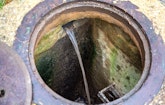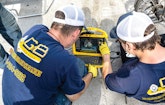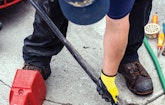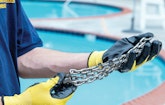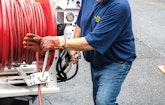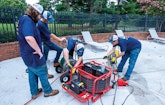
A G&B Services crew clears swimming pool drains with a Picote Maxi Miller machine at an apartment complex in Falls Church, Virginia.
Interested in Cleaning?
Get Cleaning articles, news and videos right in your inbox! Sign up now.
Cleaning + Get AlertsMany factors have helped G&B Services Plumbing and Drain Cleaning thrive in a highly competitive East Coast market. But owner Greg Beall says the company’s success essentially boils down to two simple things: investing in productive and reliable machines that provide a competitive edge, then attracting and retaining quality employees to run them.
“Over the years, I’ve learned that you’re only as good as the equipment you have and the people running it,” says Beall, age 48, who established the Bowie, Maryland-based company in 2000. “Anyone can buy a jetting machine. You can even buy a Learjet, too, if you have enough money, but that doesn’t mean you know how to operate either of them.
“Buying the best equipment and hiring experienced, knowledgeable employees give me the best chance to get called into top-of-the-line office buildings because those customers know I have the equipment and the people to get the job done. If you don’t have the best equipment, how can you expect to do the best work?”
As an example of an investment that helped bring in work cleaning drains in larger apartment buildings, Beall points to the Maxi Miller from Picote Solutions. Designed to clear roots and descale pipes, the tool also can remove concrete from pipelines, he says.
“The Maxi Miller is my go-to machine because it always gets me out of bad situations. It can do everything from removing concrete in lines to retrieving a broken (drain machine) cable in minutes.
“It paid for itself in the first week I owned it. We keep finding out by accident all the things it can do that it wasn’t even designed to do. I’m pretty sure it could even make me a sandwich if I could figure out the right button to push.”
Today, commercial drain cleaning generates about 50% of the company’s gross revenue. Customers include restaurants, bars, commercial buildings, shopping centers, high-rise office buildings and government properties in the DMV — District of Columbia, Maryland and Virginia — area it serves, he says.
MAXIMUM PERFORMANCE
The Maxi Miller offers a classic example of how investments in new equipment can propel entry into new markets. About three years ago, Beall got a call from a property management company with a big problem: Drainline backups in a 35-story luxury apartment building in Arlington, Virginia.
The key issue was lack of access. The access panels that had provided entry to clean-outs located throughout the building had been covered with slabs of marble tile during a remodeling project years earlier, he explains.
Previous contractors tried going through sink drains to unclog the lines, but the pipes were too small for drain machines to gain access to the risers. Efforts to clean the lines from stack-pipe vents on the roof also failed.
“It had me scratching my head, too, after we got called in,” he says. “But I did some research on the internet and learned how drain cleaners in New York City clean lines in high-rise buildings from the bottom up.”
Then he bought a Maxi Miller with a 400-foot-long cable and went to work. Success there led the management company to ask Beall to handle drainline maintenance at more than 20 other buildings it owned.
“After that, the word got out,” he says. “That one project jump-started our entry into drain cleaning for larger commercial buildings.”
CUT IT OUT
The Maxi Miller is adept at cutting concrete, too. Earlier this year, Beall got a call from an apartment building owner with a major problem: Flooding caused by drainlines that had accidentally been clogged by floor-leveling concrete during a remodeling project.
“I bought a new drain machine specifically for the job, but it broke down — it fried in just one day,” Beall says. “So I busted out the Maxi Miller and it cut out that concrete like it wasn’t even there.
“In fact, in some places, the pipes looked almost like new because the concrete had filled in divots, cracks and other imperfections in the old cast iron pipes. So after we drilled out the concrete, the pipes looked way better than they did before. It was incredible.”
A model 4018 trailer jetter from US Jetting (4,000 psi at 18 gpm) also plays a valuable role in the company’s efforts to boost productivity and keep customers satisfied, Beall says.
“As an investment, it’s definitely outdone itself. It helps us offer outstanding customer service on larger sites. I think it’s the best in the industry when it comes to jetting and flushing.”
ROOTS IN PLUMBING
Beall is a second-generation plumber who followed his father, Fred Beall, and stepfather, Donald Decarr, into the trade. After working at his stepfather’s company, he decided to start his own business.
For the first 10 years, Beall concentrated on commercial service and repair work and drain cleaning. The company eventually earned maintenance contracts to do work at nearly 500 Pizza Hut and Wendy’s restaurants in the DMV area.
“Maintenance contracts are good. If you do a great job and they know you provide other services, you’ve got your foot in the door,” he says. “If they find out you have a plumbing division along with drain cleaning, then all of a sudden you have most of their work. And it all started with a drain call.”
Around 2010, he branched out into new construction, motivated by the post-recession economic boom. New construction has slowed down due to the COVID-19 pandemic, but service work is booming, which illustrates the value of providing more than just one service.
“Drain cleaning is having a large impact on the company right now,” Beall says. “It continues to grow monthly and currently represents about 50% of our business.”
EQUIPMENT MATTERS
Beall estimates that during the last 20 years, he’s invested more than 40% of his annual profits in equipment. His fleet of machines included four trailer-mounted water jetters — two from US Jetting (both 4,000 psi at 18 gpm); one PipeHunter unit (3,000 psi at 24 gpm), a brand owned by Texas Underground; and one built by Jetter Depot (4,000 psi at 10 gpm). The company also owns a Shark cart-mounted jetter (Karcher North America) that provides 8 gpm at 3,500 psi.
Other drain cleaning equipment includes RIDGID K-1500 and K-50 cable drain machines; two Maxi Miller machines and one Maxi Miller Power Plus; a ZipZip flex-shaft cable machine manufactured by Drain Rehab Solutions; and two electric-powered StairCat stair-climbing hand trucks, built by Escalera.
In addition, G&B Services has invested in RIDGID SeeSnake pipeline inspection cameras of all sizes, as well as cameras from Vivax-Metrotech; a pipe bursting system from Hammerhead Trenchless; pipe lining technology from Perma-Liner Industries; and a point repair, pipe lining system from Picote Solutions.
The company also relies on six service vehicles, primarily Ford Transits; three excavators — two from Bobcat and one from Hitachi Construction Machinery; two backhoes, one manufactured by CASE Construction (a brand owed by CNH Industrial America) and one by Kubota Tractor; and three Bobcat skid-steers.
LESSONS LEARNED
Other factors also contributed to the company’s growth. For starters, Beall says he had to learn to “fire” customers that never paid on time. “Knowing when to fire a customer was one of the most valuable business lessons I ever learned,” he says.
“Those customers always are giving you just enough work to keep you busy … but you’re always chasing profit while they pay a little at a time and try to negotiate payments for the balance.
“At one point, I realized my best customer was killing me — just stringing me along. Now I outright own every piece of equipment I have because I have the cash flow to pay for it.”
Another contributor: A sharp focus on quality work and employee training. Beall impresses on his technicians that when every job is completed, it should look worthy of appearing on the cover of a plumbing magazine. To him, it’s all about attention to detail and craftsmanship.
“I tell them that plumbing is like artwork. I even make them tighten faucet handles so they’re all parallel (when shut off), like they should be.”
Furthermore, he insists on leaving job sites cleaner than when his technicians arrived.
“I make them wash floors before they leave,” he says. “Other plumbers might leave fingerprints on the wall and trash behind. But we don’t. I’ll wash down walls that weren’t even clean when we arrived. I want to do such a great job that customers feel like I forgot to charge them for something.
“In the end, building owners don’t want to hear from tenants who are angry about having to take care of the mess plumbers leave behind. Doing things this way differentiates us from other companies and leads to a lot of word-of-mouth referrals, which are our only form of advertising.”
Beall also credits the company’s success to his wife, Alethea, who runs the administrative end of the business. “I’m a damn good plumber, but I’m not a very good businessman,” he concedes. “I wouldn’t be where I am without her. She’s the genius behind the business.”
SLOW BUT STEADY
Beall enjoys his job — especially the drain cleaning work — because it’s always challenging and requires problem-solving skills. “Plus, I’m pretty good at it,” he says. “I don’t want to sound cocky, but we get called in to solve a lot of problems that other companies haven’t been able to fix.”
In addition, resolving customers’ emergency drain issues makes him and his technicians heroes every day, which he finds gratifying.
Looking ahead, Beall anticipates slow but steady growth. In the next three to five years, he says he’d like to add up to two more trucks.
He has little interest in more dramatic growth. In short, it all boils down to quality control.
“I’d rather be small and win a gold medal for quality than be much bigger and win a bronze medal,” he says. “It’s hard to control quality when you mass-produce anything.”
But one thing won’t change, no matter how much larger the company grows: the strategy that helped Beall get where he is today.
“In the end, the formula for success is pretty simple: Better guys. Better equipment. Better training.”
Getting results
When Greg Beall established G&B Services Plumbing and Drain Cleaning in 2000, he took a good, long look at what he liked and didn’t like about past bosses, supervisors and foremen.
That helped him formulate a simple, but effective management philosophy that revolves around treating his technicians the way he was treated by his favorite supervisors.
“I used to work for a guy who spent 30 to 45 minutes almost every day chewing us out if someone was late and talking about the importance of being on time,” he recalls. “Then he’d leave and we’d spend a half hour talking about him.
“I saw similar things wherever I worked … and those kinds of managers never got the kind of reaction or results they thought they were getting. I finally told him that the more time he spent bitching at us, the less time we had to work. Then I quit.”
Beall works hard to ensure his employees know he cares for and appreciates them. He periodically buys them lunch and occasionally will give them cash spot bonuses for going above and beyond on jobs, he says.
Other times, he motivates employees by buying power tools when they’re on sale, then awarding them as prizes in an employee-of-the-month competition. “They try to do an even better job, just to win those tools,” he says.
Beall also invests in quality, reliable equipment, which he also considers an employee-retention tool. He also provides training — both in-house and from equipment manufacturers — to make sure they use tool and machines to the maximum effect. Training also boosts their sense of loyalty and professionalism, he says.
To increase productivity, every technician works with a helper. Even if a job doesn’t require two people, the helper still goes along — and Beall says in those cases, he doesn’t charge customers for two laborers.
He does this in part because it helps them finish jobs faster. “So in the long run, it’s cheaper,” he says. But it also gives younger employees a great daily opportunity to see how seasoned pros go about their business.
“Every so often, I switch them up with different technicians to expose them to different ways of doing things. This also helps me figure out which guys work best together.”
This approach also helps him weed out bad employees by getting several opinions on a helper’s work, instead of relying on just one technician who might happen to like the helper and doesn’t want to criticize his work, Beall says.
So far, his management style and employee retention efforts seem to be working; he says four employees hired as helpers now are either technicians or foremen who have been with the company anywhere from five to 10 years.

